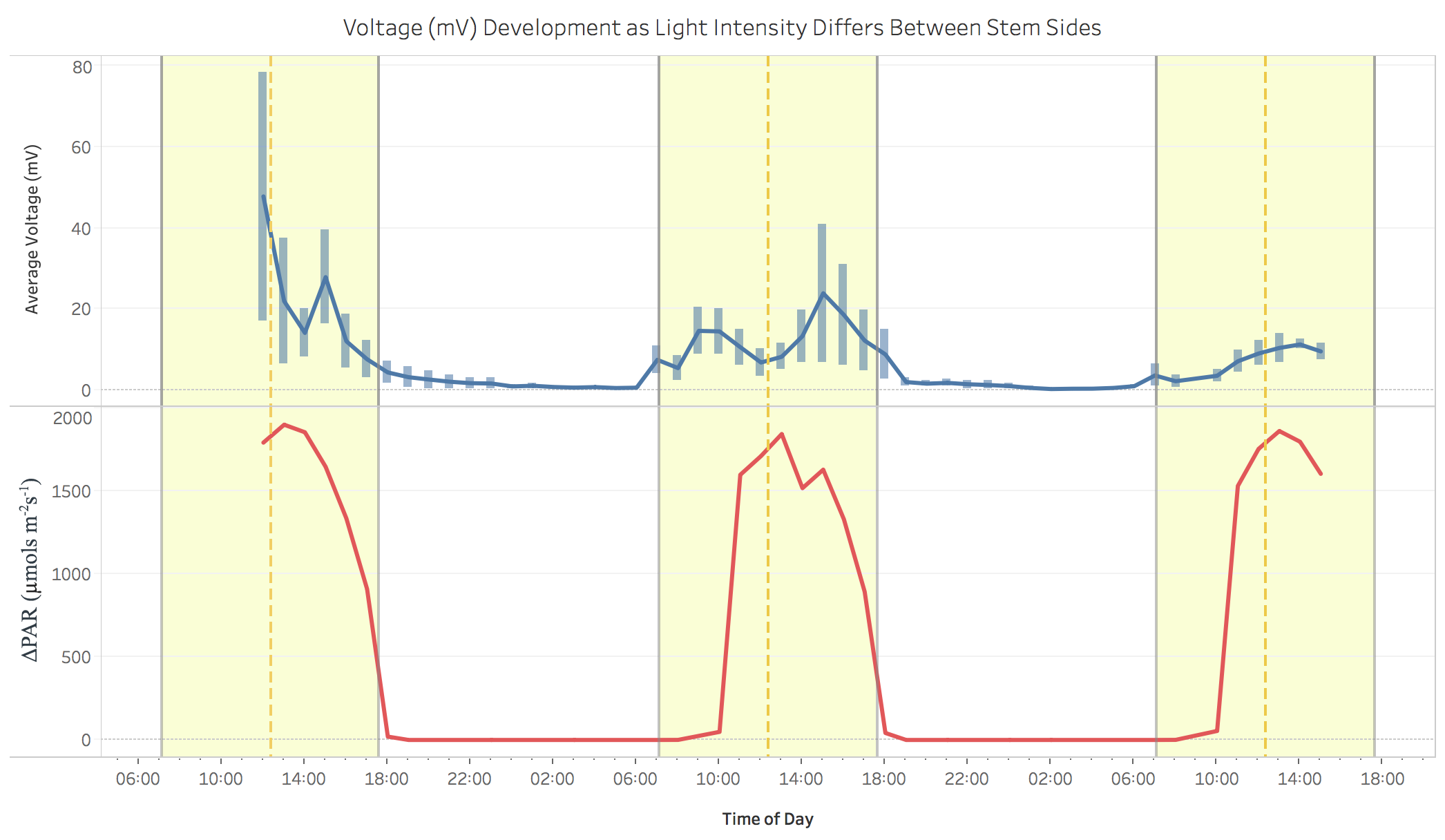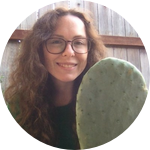About This Project
Plants absorb carbon dioxide (CO2) and sunlight to grow in a process called photosynthesis. Cacti, however, absorb CO2 at night and store it as malate, which is broken down by sunlight during the day. Cacti are opaque, so the sunny and shaded sides do this independently and a voltage difference occurs. We want to know what factors influence this voltage difference. Results could reduce the impact that renewable energy has on biodiversity via a new cactus-based electricity generation technique.
Ask the Scientists
Join The DiscussionWhat is the context of this research?
Plants photosynthesize to make sugars to grow. While most plants do this during the day, cacti undergo Crassulacean Acid Metabolism (CAM). They take up carbon dioxide at night, which is stored as a compound called malate. During the day, sunlight breaks down the malate to make sugars. Because cactus stems are opaque, sunlight cannot pass through the stem, meaning each side breaks down the malate at different rates. The concentration difference creates a voltage differential across the stem. Previous studies have harvested electricity from electrical potentials in living plants, such as the pH differences between tree tissue and soil, yet none have attributed the voltage potential to CAM. We will explore how much of this electricity can be harvested and the factors that influence voltage.
What is the significance of this project?
Meeting climate goals requires a shift away from fossil fuels and towards adopting more renewable energy. Unfortunately, utility-scale renewable energy systems, like wind and solar, have detrimental effects on avian populations. For instance, thousands of birds die each year in California from impact collision injuries with solar panels at utility-scale solar facilities. The results of our research will increase the understanding of how voltage develops in living CAM plants and if this electricity can be harvested. Future research can then explore the potential of plant-based electricity to supplement renewable energy demands with a lower impact to wildlife. Cactus-based electricity could help meet rising renewable energy demands while also meeting biodiversity conservation goals.
What are the goals of the project?
Our goal is to answer the questions: How much electricity can we harvest from prickly pear stems? and What factors influence the voltage difference? We have broken these overarching goals into five sub-goals:
1) measure how much electricity can be harvested from the stems;
2) understand how metal electrode composition influences the amount of electricity harvested;
3) refine the electricity harvesting device based on electrode results;
4) deploy 20 devices at a commercial cactus farm for a year to determine how seasonal environmental conditions (sunlight, temperature, soil moisture) influence electricity production; and
5) publish the results of this research and conduct future research that compares cactus-based electricity to other energy sources.
Budget
Funds raised through backers will enable me to understand what factors influence voltage difference. I will design an electricity harvesting system and experiment to see how much electricity can be harvested from the cactus stem when altering different electrode metal types and the number of wires in series. I will use a 3D printer to print an object to hold electrodes and wires in place. I will then build 20 additional systems to monitor prickly pears at a farm for one year to see how weather influences the amount of electricity we can harvest. Because the devices have remote capabilities to enable me to monitor data, I will need to fund a hotspot data plan. I am also seeking funds to provide a stipend for several undergraduate students to assist me on this project for one year. They will gain field experience and will have opportunities for a related independent project. Funds will help me move my PhD research forward and towards establishing a new electricity source.
Endorsed by
 Project Timeline
Project Timeline
I aim to begin designing, building, and programming the electricity harvesting device this summer. I will conduct electrode experiments in early Fall. I will build additional devices in early winter to begin the prickly pear farm environmental factors experiment in spring 2023. I will conclude the experiment in spring 2024 and analyze the results in summer 2024. Results will be published in early 2025.
Apr 22, 2022
Project Launched
Jul 01, 2022
Begin building electricity harvesting system
Aug 01, 2022
Begin electricity harvesting experiment
Oct 01, 2022
Begin electrode experiment
Nov 01, 2022
Begin wire number in series experiment
Meet the Team
Affiliates
Affiliates
Team Bio
The Living Solar Panels team is led by Charlie Chesney. The original idea stems from Dr. Michael Loik who advises the project. Three undergraduate students are currently on the team, Erin Langness, Joe Zheng, and Angelina Powers, with two more joining this summer. Read our field notes to learn more about them!
Charlie Chesney
I'm Charlie Chesney (she/her), a 2nd year Environmental Studies PhD student at the University of California - Santa Cruz. I'm part ecologist part engineer and all around science nerd. I am most motivated by the challenge of helping humanity thrive without compromising our natural world. For me, this means crossing sectors between ecology and engineering. I'm intrigued by ideas that initially sound impossible and require me to learn new skills (like soldering!). I chose to work on Living Solar Panels because it allows me to be a mad scientist while helping people and our planet.
Before diving into cactus-based energy, I worked in education, sustainability analytics, restoration, avian conservation, and animal behavior studies. Highlights from my prior work include being vomited on by a California Condor and winning a Conservation Technology X Prize. I hold a MSc in Biodiversity, Conservation, and Management from the University of Oxford and a BSc in Biology/Zoology from San Francisco State University. I hope to remain in a research and development role after receiving my PhD and can see myself as a future CEO.
When I'm not in the lab or greenhouse, you can find me at the rock climbing gym, bird watching on the beach, or tie dying thrifted clothes. Find out more about me at www.charliechesney.com!
Michael E. Loik
I am trained as a biophysical plant ecologist. Most of my work has focused on how plants survive the tough conditions of their environment, particularly in terms of climate change. This has taken place in deserts and mountains primarily, but also in grasslands and tropical forests. More recently, my research team has been developing new technologies, such as Living Solar Panels, to help reduce greenhouse gas emissions and put the brakes on global warming.
Additional Information
 Initial data show voltage does indeed develop across the prickly pear stem! Despite this being only three days of data, it is a promising indication that environmental conditions, such as light level, influences voltage differences between the two sides of the stem. Read more about this result in our lab notes!
Initial data show voltage does indeed develop across the prickly pear stem! Despite this being only three days of data, it is a promising indication that environmental conditions, such as light level, influences voltage differences between the two sides of the stem. Read more about this result in our lab notes!
Follow Living Solar Panels on Twitter, Instagram, and Facebook!
Project Backers
- 11Backers
- 16%Funded
- $1,512Total Donations
- $137.45Average Donation


